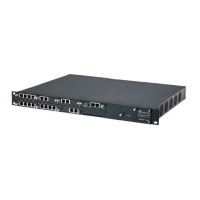Version 6.6 745 October 2014
Installation & Operation Manual 43. Session Border Controller (SBC) Application
43.11 SBC Routing
The SBC application employs a comprehensive and flexible routing scheme:
Routing rules according to Layer ¾ and SIP characteristics
Routing to multiple destination types:
• Request-URI (of incoming SIP dialog initiating requests)
• Specific destination IP address
• Specific FQDN (NAPTR/SRV/A-Record Resolutions)
• Registered Contact in device's database (User-type IP Groups)
• IP Group (address defined for Proxy Set associated with the IP Group), with
the ability of load balancing and redundancy
Alternative Routing
Routing between two different Layer-3 networks (LAN-WAN etc.)
Transport protocol translator (UDP to TCP to TLS)
Source and destination user name manipulation (pre/post routing)
43.11.1 SBC IP to IP Routing Table
The SBC IP to IP Routing table provides enhanced IP-to-IP call routing capabilities for
routing received SIP messages (such as INVITE or REGISTER) to a destination IP
address. The routing rule must match one of the following input characteristics:
Source IP Group, Source Phone Prefix, and/or Source Host Prefix.
Note: SIP REGISTER messages are routed only by using Destination IP Groups
defined in the SBC IP-to-IP routing rules.
The IP2IP Routing table determines the destination route according to any one of the
following:
Registered User Contact listed in the device's database (only for USER IP
Groups)
Destination IP Group's associated Proxy Set (allows redundancy/load balancing)
Specific destination address (can be based on IP address, Host name, port,
transport type, and/or SRD). Routing to a host name can be resolved using
NAPTR/SRV/A-Record.
Incoming Request URI

